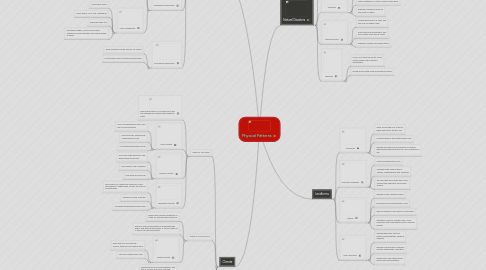
1. Agriculture
1.1. Effect of CLIMATE
1.1.1. climate helps (or doesn't) create fertile soil, because wind and water erodes soil
1.1.2. needs a proper climate for plants to grow and nourish
1.2. Effect of SOIL
1.2.1. soil profile shows layers of soil, and can show how fertile soil is
1.2.2. often, the darker the soil, the more fertile
1.2.3. permafrost is when the soil is frozen solid permaneantly
1.3. Effect of NATURAL VEGETATION
1.3.1. trees, flowers, grass, and plants from before are natural vegetation
1.3.2. chopped away for many reasons, like farming and building roads
1.3.3. trees, flowers, grass, and plants from before are natural vegetation
1.3.4. different types of plants in the past can effect how fertile the soil is, because if what decomposes is poisonous, the soil won't be very fertile
1.4. Subsistence Agriculture
1.4.1. Nomadic Herders
1.4.1.1. use goats, camels or cattle for transportation, and sometimes for livestock, and different parts of an animal may provide things like milk and hair
1.4.1.2. sometimes trade live animals for small extravangeces
1.4.2. Shifting Cultivators
1.4.2.1. clear parts of ecozones to farm
1.4.2.2. after the soil becomes less fertile, these people move
1.4.3. Small Landholders
1.4.3.1. permanent farms
1.4.3.2. many grains, corn, rice, vegetables
1.4.3.3. everyone helps out
1.4.3.4. sometimes trades, and a small climate change can effect whether their plants wither or thrive
1.5. Commercial Agriculture
1.5.1. grow one type of food and sell for money
1.5.2. most farmers don't eat the food they grow
2. Climate
2.1. Effect of LATITUDE
2.1.1. effects how warm or cold the sun's rays are depending on where they strike the Earth
2.1.2. Polar Climate
2.1.2.1. very cold because the sun's rays are not concentrated
2.1.2.2. near the poles, example like Verkhoyansk, Russia
2.1.2.3. cold temperatures year round
2.1.3. Tropical Climate
2.1.3.1. sun's rays strike Earth at a very direct angle in this area
2.1.3.2. near equator, like Singapore
2.1.3.3. very warm all year long
2.1.4. Temperate Climate
2.1.4.1. near Tropics of Cancer and Capricorn; sun's rays strike at a slight angle, so rays' are not too concentrated
2.1.4.2. example is Perth, Australia
2.1.4.3. moderate temperatures year round
2.2. Effect of MOVING AIR
2.2.1. effects how much precipitation is in the air, and how warm the air is
2.2.2. warm air rises because the sun evaporates the water, and when it goes down, it forms clouds so it rains a lot near the equator
2.2.3. Desert Climate
2.2.3.1. when the cool air nears the Tropics, they become regular wind
2.2.3.2. very dry climate year round
2.3. Effect of WATER BODIES
2.3.1. affects the amount of precipitation you find in an area, and often, also the humidity
2.3.2. Maritime Climate
2.3.2.1. lots of water nearby, and because of so much water, there's more precipitation
2.3.2.2. has warm summers and cool winters
2.3.2.3. example is Vancouver, Canada
2.3.3. Continental Climate
2.3.3.1. not near bodies of water, therefore there's not much precipitation
2.3.3.2. very extreme temperatures; hot summers and cold winters
2.3.3.3. example is Winnipeg, Canada
2.4. Effect of MOUNTAINS
2.4.1. Mountain Climate
2.4.1.1. back of mountain is cooler, since there isn't any sunlight
2.4.1.2. colder higher up, because there's less molecules to capture the heat
2.4.1.3. places like Quito, Ecuador
2.4.2. less oxygen, so there's less heat, which makes it colder
2.5. Effect of OCEAN CURRENTS
2.5.1. warm water flows away from equator along shoreline
2.5.2. cold currents flow from poles to equator
2.5.3. people used to use these currents to get to new places
2.5.4. can make a place warm and cold depending on the temperature of the current
3. Natural Disasters
3.1. Earthquakes
3.1.1. most earthquakes aren't strong enough to do any damage
3.1.2. earthquakes occur when tectonic plates are separated, dragged together, or dragged next another one
3.1.3. earthquakes occur every three seconds
3.1.4. an example includes the earthquake in Haiti
3.2. Tsunamis
3.2.1. caused when an earthquake shakes the ground below the ocean
3.2.2. often mistaken for a storm surge or tidal wave
3.2.3. example includes tsunami on the coast of Japan
3.3. Tropical Storms
3.3.1. caused when warm air rises, and the cold air makes it spin
3.3.2. most start near the equator, and don't affect areas too far north
3.3.3. example includes Hurricane Katrina
3.4. Blizzards
3.4.1. occurs in or near the Arctic Circle; affects areas in the northern hemipshere
3.4.2. strong storms with snow and powerful winds
4. Landforms
4.1. Volcanoes
4.1.1. many around the Mid- Atlantic Ridge and Pacific Ring of Fire
4.1.2. contains igneous and metamorphic rock
4.1.3. example includes Mount Vesuvius in Pompeii, which destroyed the entire city, and covered in in ash
4.2. Plains and Lowlands
4.2.1. made of sedimentary rocks
4.2.2. example is the Great Plains in Alberta, Saskatchewan and Manitoba
4.2.3. the land that forms when the ocean erodes away sediment from shield regions
4.3. Shields
4.3.1. example is the Canadian Shield
4.3.2. has igneous and metamorphic rocks
4.3.3. they are usually in the center of continents
4.3.4. created by volcanic activity many, many years ago; that`s why there`s lots of volcanic activity
4.4. Fold Mountains
4.4.1. created when two tectonic plates collide together, pushing upwards
4.4.2. examples include the Himalayas and the Appalachian Mountains
4.4.3. sedimentary and metamorphic rocks form fold mountains
